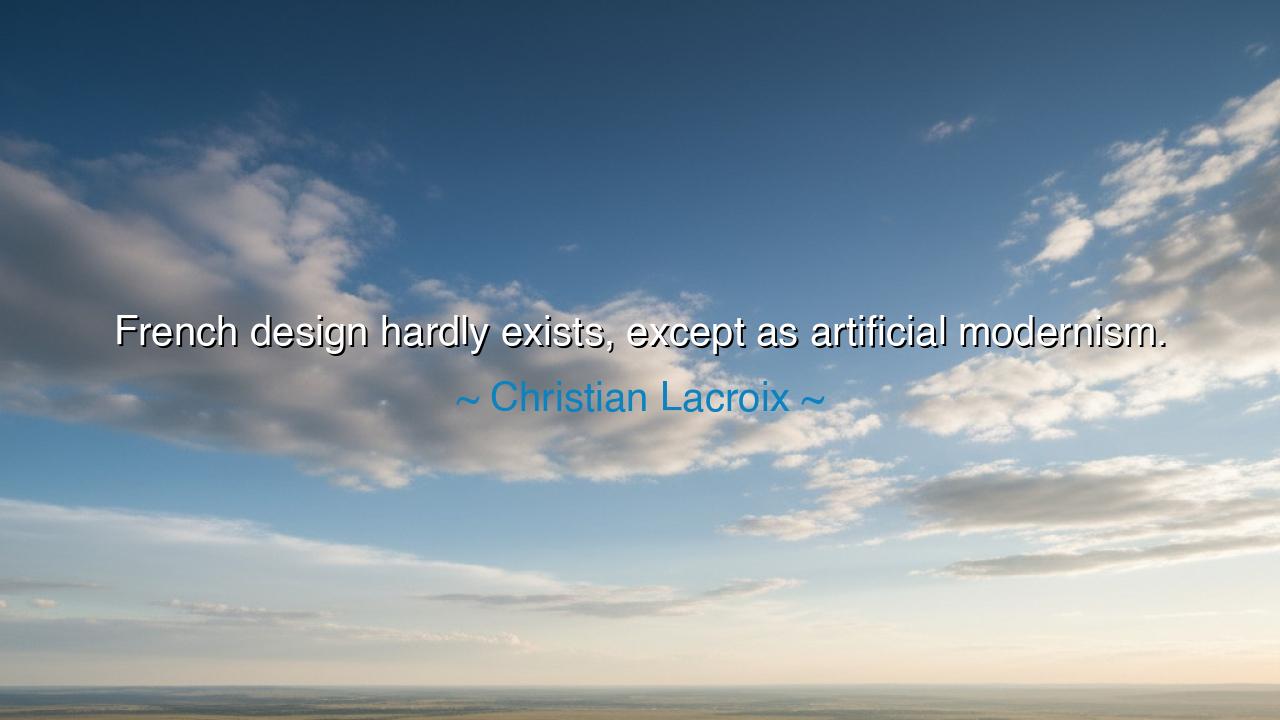
French design hardly exists, except as artificial modernism.






“French design hardly exists, except as artificial modernism.” Thus spoke Christian Lacroix, the couturier whose hands once shaped the splendor of fabric into poetry. His words, sharp as a blade and wistful as memory, are not merely a criticism of design — they are a lament for a lost spirit, a meditation on authenticity and identity in an age of imitation. In this sentence, Lacroix reveals both his love and his sorrow for his culture: a love for the soul of French art, and a sorrow that it has been replaced by artificial modernism, a surface brilliance that lacks the fire of creation’s truth.
When Lacroix declares that “French design hardly exists,” he does not deny France’s proud heritage of beauty — the grandeur of Versailles, the elegance of Art Deco, the refinement of haute couture. Rather, he mourns that in the modern age, these living traditions have been hollowed out, replaced by design that copies form but forgets meaning. He speaks of a time when creation flowed from passion and philosophy, when design was the expression of a people’s spirit. But now, in a world obsessed with novelty and speed, he sees much of design reduced to what he calls “artificial modernism” — a mimicry of progress, stripped of soul, severed from history.
The origin of this quote lies in Lacroix’s own struggle between the old and the new. Born in the land of Provence, surrounded by sunlight and tradition, he rose to fame in the glittering world of Parisian couture. His creations were bold, theatrical, and deeply nostalgic — full of color, romance, and historical reference. Yet in the late twentieth century, as fashion turned toward minimalism and industrial design, Lacroix found himself at odds with a world that seemed to prize sleek uniformity over individuality. Thus, his statement is not merely artistic — it is prophetic. It is the cry of a creator who sees beauty losing its soul to the machinery of modern taste.
To understand this lament, one must recall the history of modernism itself — that great artistic wave that once sought purity and truth through simplicity. At its birth, modernism was honest and brave; it stripped away excess to reveal the essence beneath. But as time passed, its language became a formula, its daring became dogma. The “artificial modernism” of which Lacroix speaks is not true modernism, but its ghost — a style that imitates innovation without understanding it, that replaces sincerity with surface, and substance with abstraction. It is creation without roots, beauty without story.
There is an echo of this truth in all the arts, across all ages. Consider ancient Rome, which inherited the art of Greece. In its early days, Roman artists learned from Greek masters, but they infused their works with their own grandeur and realism. Yet as the empire grew wealthy, imitation replaced invention; marble gods became decorative symbols rather than divine expressions. The spirit of art faltered, and decline followed. What Lacroix describes in France’s design world is a reflection of this same eternal cycle — when imitation overwhelms inspiration, when creators forget that beauty must be born from conviction, not convention.
Yet within this lament, there lies a lesson of renewal. Lacroix’s words, though sorrowful, carry a seed of hope: for to recognize the artificial is to yearn for the authentic. He calls upon artists, designers, and dreamers to remember their heritage, to rediscover the sincerity that once made their craft divine. True creation is never dead — it merely sleeps, waiting for those who dare to awaken it. The task of the artist, then, is not to reject modernity, but to redeem it — to infuse even the new with the warmth of soul, with history, and with meaning.
Let the listener take heed of this wisdom: Do not create for applause, create for truth. Do not mistake the polished surface for perfection, nor speed for progress. Whether one works in design, art, words, or life itself, the challenge remains the same — to build something real in a world of imitation. Seek to craft works that live, not merely exist; that move the heart, not merely please the eye.
For in the end, as Christian Lacroix reminds us, the measure of design — and of all human creation — is not how new it seems, but how deeply it breathes. The artificial may dazzle for a moment, but the authentic endures for generations. Therefore, create not to follow the fashion of the times, but to honor the eternal — and let every work you leave behind bear the mark not of modernity, but of meaning.






AAdministratorAdministrator
Welcome, honored guests. Please leave a comment, we will respond soon